Conlang/Advanced/Grammar/Government/Structural relationships
< Conlang < Advanced < Grammar < GovernmentStructural Relationships
Trees structures, as previously mentioned, have distinct components, the nodes, that contain or are contained by other nodes. This hierarchy of containment, and co-contained-ness, allows us to identify certain relationships between nodes that are useful in describing why things behave the way they behave in a language.
Parts of a Tree
Starting with some simple PS rules
- 1) A → B C
- 2) B → D E
- 3) C → F G
- 4) F → H
we can generate a tree
- 5)

 We can now explore the different parts of trees. A, B, ... are examples of nodes. Nodes are connected to one another by lines, which differentiate branches. B, and the nodes below it, form a branch distinct from C and the nodes below C. D is a distinct branch from E, and so on. If a node has only one branch below it, it’s said to be non-branching; if it has more than one branch below it, it’s branching.
- 6)
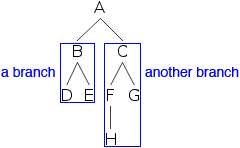
- 7)
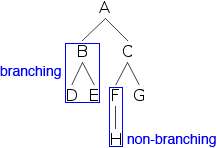
 At the top of the tree we find A, which is not below any other node. Such nodes are root nodes. At the bottom we find D, E, H, and G, which have no nodes below them. Such nodes are terminal nodes (sometimes called leaf nodes). The nodes A, B, C, and F, all have nodes below them, and are called non-terminal nodes. The actual letters given to the nodes are called labels.
Terminal nodes are almost always heads (in the advanced syntax tutorial we’ll say that all terminal nodes are also heads), and all non-terminal nodes are phrases.
Domination Structures
The simplest kind of structural relationship between nodes is a dominance relationship. A node dominates another node if it’s above that node in the tree. In the example tree, A dominates all other nodes, B dominates D and E, C dominates F, H, and G, and F dominates H.
- 8) A node X dominates another node Y if and only if X is higher in the tree than Y (i.e. fewer nodes between X and the root node) and you can trace a path between X and Y by going in only up from Y to X or only down from X to Y.
We can also make statements about which collections of terminal nodes are dominated by which other nodes. For instance, the set {D, E} is dominated by both B and A. With B, the set is the same as the set of nodes dominated by B, but with A, the set is only some of the nodes dominated by A. We can say then that B exhaustively dominates the set, but A doesn’t.
- 9) A node X exhaustively dominates a set of terminal nodes {Y, ..., Z} if and only if X dominates all members of the set, and all terminal nodes dominated by X are members of the set.
- 10)
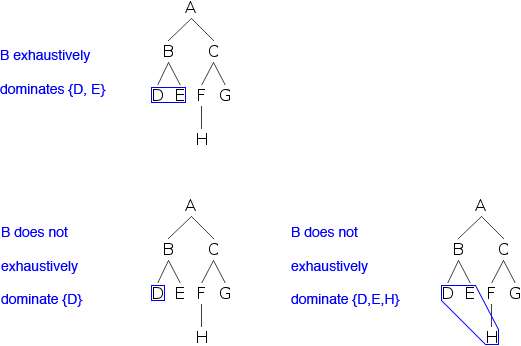
Immediacy
 We can also notice relationships between how far nodes are from one another in a dominance relationship. Some nodes, such as F, are directly above other nodes, in this case H, while other dominating nodes, such as A, are not directly above. When a node is directly above another node, it immediately dominates that node.
- 11) A node X immediately dominates a node Z if and only if X dominates Z and there’s no node Y that dominates Z and is itself dominated by X.
- 12)

A node that immediately dominates another node is called the mother of that other node. A node that is immediately dominated by another node is called the daughter of that other node. Daughters of the same node are called sisters.
Another simple relationship that can be described in terms of domination is constituency.
- 13) A node X is a constituent of a node Y if and only if Y dominates X.
- 14)
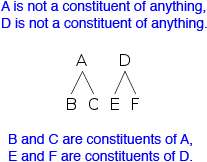
Precedence Structures
Precedence is not as simple as dominance, but still quite simple. A node precedes another node if it appears before that node. But there are two distinct kinds of precedence, and one kind depends on the other.
- 15) A node X sister-precedes a node Y if and only if both X and Y are immediately dominated by the same node and X appears to the left of Y.
- 16)
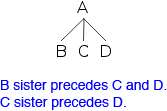

- 17) A node X precedes a node Y if and only if neither node dominates the other and X or a node dominating X sister-precedes Y or a node dominating Y.
- 18)
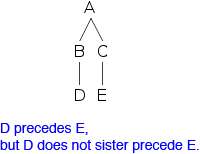
Immediacy
Immediacy of precedence can play an important role in the analysis of things like direct vs. indirect objects. Immediacy in precedence is similar to immediacy in dominance, so the definition will be similar.
- 19) A node X immediately precedes a node Z if and only if X precedes Z and there’s no node Y that precedes Z and is itself preceded by X.
- 20)
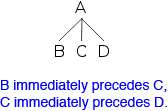
C-command
C-command is probably the most useful structural relationship when it comes to building a theory for how a language works syntactically. A c-command relationship should be easy to grasp if you understand dominance and sister-hood. Basically, a node c-commands another node if it’s sister to that node or sister to a node that dominates that node.
- 21) A node X c-commands a node Y if and only if the node immediately dominating X also dominates Y.
You can find c-commanded nodes visually by following a simple rule: Go up one then down one or more, and any node you land at will be c-commanded by the node you started at.
- 22)
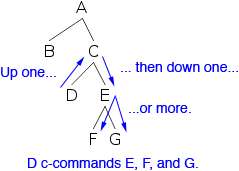
Symmetry
C-command relationships can show symmetry, as well. Symmetry can play an important role in the behavior of certain constituents. Symmetric c-command is essentially a sister relationship. Asymmetric c-command is essentially all other c-commanding situations.
- 23) A node X symmetrically c-commands a node Y if and only if X c-commands Y and Y c-commands X.
- 24) A node X asymmetrically c-commands a node Y if and only if X c-commands Y and Y doesn’t c-command X.
- 25)


Government
Government is another important relationship. It’s built on top of c-command and so it’s easy to define in those terms. It looks very similar to immediacy relationships.
- 26) A node X governs a node Z if and only if X c-commands Z and there’s no node Y that c-commands Z and is itself c-commanded by X.
- 27)

Phrase/Head
Some government relationships only apply between heads or between phrases. We can define two sub-types of governance based on the types of the participating nodes.
- 28) A node X head-governs a node Z if and only if X c-commands Z, there’s no node Y that c-commands Z and is itself c-commanded by X, and X, Y, and Z are all heads/terminal nodes.
- 29) A node X phrase-governs a node Z if and only if Z c-commands X, there’s no node Y that c-commands Z and is itself c-commanded by X, and X, Y, and Z are all phrases/non-terminal nodes.
- 30)
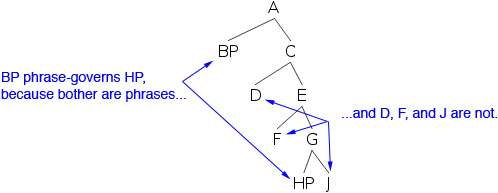
- 31)
Grammatical Relationships
The last kind of relationship is the grammatical relationships. These aren’t structural relationships at all, but rather semantic relationships that tend to end up taking on the same structural form in language after language. Some of these will be revised in the advanced syntax tutorial.
These relationships depend entirely on the PS rules of a language, in this case English.
- 32) Subject (S): The NP or CP daughter of a TP.
- 33) (Direct) Object (O or DO): The NP or CP daughter of a VP headed by a transitive verb.
- 34) Object of a Preposition: The NP or CP daughter of a PP.
- 35)
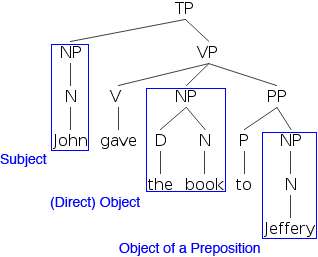
 English has type of object called an Indirect Object (IO). Indirect objects can sometimes appear as a normal Object or sometimes as the Object of a Preposition.
- 36)
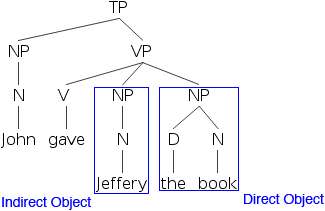
- 37)
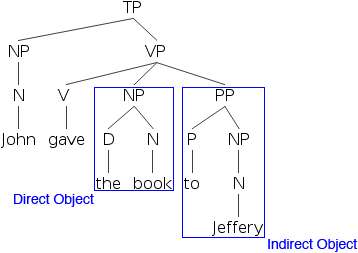
 Now that we have two kinds of objects that both can be NP daughters of VPs, we need to redefine the term Direct Object, and also define an Indirect Object.
- 38) Direct Object (v2):
- a) The NP or CP daughter of VP, with a V[NP __ NP], V[NP __ CP], V[NP __ {NP/CP}], and V[NP __ NP PP]
- b) An NP or CP daughter of VP that’s sister-preceded by an NP or PP, with a V[NP __ {NP/PP} {NP/CP}]
- 39) Indirect Object:
- a) The PP daughter of VP immediately preceded by an NP daughter of VP, with V[NP __ NP PP]
- b) The NP daughter of VP immediately preceded by V, with V[NP __ NP {NP/CP}]
There’s another kind of object, the Oblique Object, which is usually marked with a preposition, as in:
- 40) I eat toast [PP with jam].
Oblique Objects can show up in the same positions as Indirect Objects, and sometimes in the position of a Direct Object. What makes an Oblique Object distinguishable from other kinds of objects is whether or not it shows up in the argument feature for the verb. For instance, the verb “eat” has the argument feature [NP __ NP]. If a PP, such as “with jam”, shows up in the sentence, it must be an oblique object, since it’s not indicated in the argument feature.